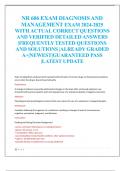NR 606 EXAM DIAGNOSIS AND
MANAGEMENT EXAM 2024-2025
WITH ACTUAL CORRECT QUESTIONS
AND VERIFIED DETAILED ANSWERS
|FREQUENTLY TESTED QUESTIONS
AND SOLUTIONS |ALREADY GRADED
A+|NEWEST|GUARANTEED PASS
|LATEST UPDATE
State of adaptation produced with repeated administration of certain drugs so that physical symptoms
occur when the drug is discontinued abruptly.
Dependence
A change in behavior caused by biochemical changes in the brain after continued substance use
characterized by preoccupation with and repeated use of a substance despite of negative outcomes.
Addiction
Physiological and psychological reactions that occur when the use of a substance is stopped abruptly.
Withdrawal
Condition following the ingestion of a substance resulting in changes in level of consciousness,
cognition, perception, judgment, and behavior.
Intoxication
Feeding and Eating Disorders Background
-severe, persistent disturbances in eating behaviors
-approx. 9% of pop. in U.S.
• costing $64.7 billion per year
-second deadliest mental health condition, after opioid overdoses
• approx. 10,200 deaths per year
-typically develop in adolescence or young adulthood
1|Page
,-more common in women
-serious physical effects, contribute to psychological distress, disruptions in social functioning
Feeding and Eating Disorders Risk Factors
-Complex biopsychosocial factors
-may experience neurobiological differences
• serotonin and dopamine
-Cultural norms
• idealize a thin appearance
-Genetics
-Biochemical factors
-Psychological factors
-Trauma from abuse or bullying
-Family dysfunction
-Emotional needs not met
-Cultural factors
Which of the following factors impact the development of eating disorders? Select all that apply.
parental attitudes to gender roles
having a close relative with an eating disorder
weight stigma in the culture
trauma
intense family expectations related to physical appearance
having a close relative with an eating disorder
weight stigma in the culture
trauma
intense family expectations related to physical appearance
Rationale: Family history that includes a close relative with an eating disorder, weight stigma in the
culture or family, trauma (especially physical or sexual abuse), and a history of being bullied about
weight or physical appearance may increase the risk for eating disorders.
Which of the following are common characteristics of individuals with eating disorders? Select all that
apply.
perfectionism
low self-esteem
2|Page
,high levels of responsibility
narcissism
perfectionism
low self-esteem
Rationale: Clients with eating disorders sometimes present with a negative, subjective appraisal of
themselves, perfectionism, body image dissatisfaction, and a history of an anxiety disorder.
Anorexia Nervosa
-characterized by restrictive eating patterns, extremely low body weight, and an intense fear of gaining
weight
-may engage in excessive exercise as means of controlling weight
-affects 1-2% of pop.
• 0.3% of adolescents
Anorexia Nervosa DSM-5-TR dx
requires each of the following:
-restriction of intake leads to significantly low body weight in the context of age, sex, developmental
trajectory, and physical health
-intense fear of gaining weight or of becoming fat or persistent behavior that interferes with weight gain
-disturbance in the way in which one's body weight or shape is perceived, undue influence of body
weight or shape on self-evaluation, or lack of recognition of the seriousness of the current low body
weight
severity of anorexia nervosa
based on BMI:
-Mild: Less than or equal to 17 kg/m2
-Moderate: BMI 16 to 16.99 kg/m2
-Severe: 15 to 15.99 kg/m2
-Extreme: Less than 15 kg/m2
anorexia nervosa medical complications
impact most major organ systems
-Cardiovascular
• Structural changes
• Functional changes
-Gynecologic & Reproductive
• Secondary amenorrhea, Decreased libido, pregnancy complications.
-Endocrine
• hypothalamic-pituitary abnormalities, contribute to severe bone loss
-Gastrointestinal
• diarrhea, constipation, elevated LFTs, SMA syndrome, pancreatitis, GERD, dysphagia
-Renal & Electrolytes
3|Page
, • Decreased GFR; diuresis, hyponatremia, dehydration
-Pulmonary
• dyspnea, pneumonia
-Hematologic
• Cytopenia, bone marrow changes
-Neurologic
• Wernicke encephalopathy, Korsakoff syndrome, brain atrophy, other brain structure changes
-Dermatologic
anorexia nervosa Dermatologic Cutaneous manifestations:
-Xerosis (dry, scaly skin)
-Lanugo-like body hair (fine, downy, dark hair)
-Telogen effluvium (hair loss)
-Carotenoderma (yellowing)
-Acne
-Hyperpigmentation
-Seborrheic dermatitis (erythema and greasy scales)
-Acrocyanosis (cold, blue, and occasionally sweaty hands or feet)
-Perniosis (painful or pruritic erythema)
-Petechiae
-Livedo reticularis (reddish-cyanotic circular patches)
-Paronychia (inflamed lateral and posterior nail folds)
-Pruritus
-Striae distensae (erythematous or hypopigmented linear patches)
-Slower wound healing
_____% of individuals with anorexia nervosa excessively exercise
40-80%
-behavior often described as compulsive
-excessive exercise
• interferes with important tasks
• exceeds 3 hrs/day
• causes distress if unable to exercise
• done at inappropriate times/places, no attempt to stop
• done despite serious injury, illness, medical complications
• beyond amount of calories consumed that day
excessive exercise short term issues
dehydration
fatigue
chronic back pain
injuries
strains and sprains
stress fxs
4|Page




